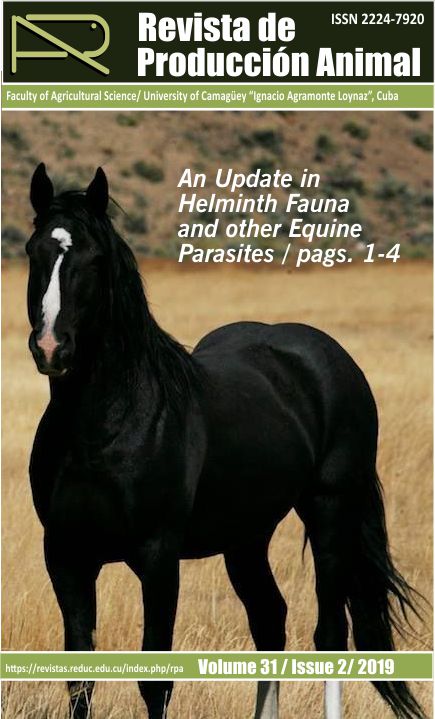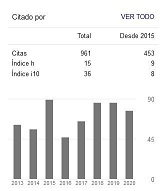Seasonal Behavior of Leptospirosis in Horses during a Decade in Camagüey
Resumen
Background: Leptospirosis is the most widely spread zoonosis during the 2000s. Numerous animal species act as reservoirs of spirochetes. The aim of this research was to establish its seasonal behavior in equines.
Methods: In that sense, the data from 1,099 equine serum reactive to Leptospira collected on a monthly basis for 10 years, were used. Seasonal decomposition was performed by the multiplicative method, which helped set sea-sonality in quarters, according to the proportion of positive reactors for the ten-year period.
Results: The greatest proportion of reactors took place in October, November, and December, when the seasonal factor was above 100%. It coincided with the dry period, which did not correspond to most reports on humans and other animal species.
Conclusions: Most horses reactive to Leptospira corresponded with the fourth quarter of the period studied: in the dry season, which contrasts most reports. Therefore, further studies should be conducted.
Descargas
Citas
Barreto, G.; Barreto, H.; Rodríguez, H.; García, T. y Vázquez, R. (2017). Reservorios de Leptospirosis en Cama-güey, dos resultados, una misma base de datos. MEDISAN, 21(10), 3020-3027.
Barreto, G. y Rodríguez, H. (2018). La leptospirosis en las producciones caprinas. Reseña. Rev. Prod. Anim.; 30(3), 57-62.
Båverud, V.; Gunnarsson, A.; Olsson Engvall, E.; Franzén, P. y Egenvall, A. (2015). Leptospira seroprevalence and associations between seropositivity, clinical disease and host factors in horses. Acta Veterinaria Scandinavica; 51(1), 15. Retrieved on January 23, 2019, from http://www.researchgate.net/publication/24244003_Leptospira_seroprevalence_and_associations_between_seropsitivityclinicaldiseaseandhostfactorsinhorses
Castillo-Cuenca, J. C.; Iannacone, J.; Fimia-Duarte, R.; Quiñones-Prieto, M. C.; Cepero-Rodríguez, O.; Dianela Cruz-Rodríguez, D. y Campos-Cardoso, L. M. (2016). Comportamiento epidemiológico de la leptospirosis hu-mana y animal en la provincia de Villa Clara, Cuba. The Biologist, 14(1), 89-102.
Chatterjee, P.; Bhaumik, S.; Chauhan, A. S. y Kakkar, M. (2017). Protocol for Developing a Database of Zoonotic Disease Research in India (DoZooRI). BMJ Open, 7(1), 17-25.
Ghazaei, C. (2018). Pathogenic Leptospira: Advances in understanding the molecular pathogenesis and virulence. Open Veterinary Journal, 8(1), 13-24.
Hamond, C.; Martins, G.; Lawson-Ferreira, R.; Medeiros, M. A. y Lilembaum, W. (2013). The role of horses in the transmission of leptospirosis in an urban tropical area. Epidemiology and Infection, 141(1), 33-35.
Martins, G. y Lilenbaum, W. (2013). The panorama of animal leptospirosis in Rio de Janeiro, Brazil, regarding the seroepidemiology of the infection in tropical regions. BMC Veterinary Research, 9(237) 1- 10. Retrieved on Jan-uary 23, 2019, from https://www.biomedcentral.com/1746-6148/9/237
Mattar, S.; Tique, V.; Miranda, J.; Montes, E. y Garzon, D. (2017). Undifferentiated tropical febrile illness in Cordo-ba, Colombia: Not everything is dengue. Journal of Infection and Public Health, 10 (1), 507-512.
Jung, B. Y.; Lee, K. W. y Ha, T. Y. (2010). Seroprevalence of Leptospira spp. in Clinically Healthy Racing Horses in Korea. Journal of Veterinary Medical Science, 72(2), 197-201.
Oliveira, MAA.; Leal, E. A.; Correia, M. A.; Serufo Filho, JSC.; Dias, R. S.; Serufo, J. C. (2017). Human leptospirosis: occurrence of serovars of Leptospira spp. in the state of Minas Gerais, Brazil, From 2008 to 2012. Brazilian Journal of Microbiology, 48(2017), 483-488.
Rodríguez, H.; Barreto, G.; García, T. y Vázquez, R. (2017a). Animales domésticos como reservorios de la Leptospi-rosis en Camagüey; papel de la especie equina. REDVET, 18(4), 4-10.
Rodríguez, H.; Barreto, G.; García, T. y Vázquez, R. (2017b). Animales domésticos como reservorios de la Leptospi-rosis en Camagüey, papel de los cerdos. Rev. Prod. Anim., 29 (3), 12-15.
Torres Castro, M.; Hernández Betancourt, S.; Agudelo Florez, P.; Arroyave Sierra, P.; Zavala Castro, J. y Puerto Fer-nando, I. (2018). Leptospirosis: enfermedad zoonótica endémica en América. Salud y Ciencia, 22(8), 778-80.
Los autores de los artículos publicados en RPA retienen los derechos de autor de su trabajo, de marca y patente, y también sobre cualquier proceso o procedimiento descrito en el artículo, así como a compartir, copiar, distribuir, ejecutar y comunicar públicamente el artículo publicado en la RPA o cualquier parte de aquel siempre que indiquen la fuente de publicación (autores del trabajo, revista, volumen, número y fecha), pero están de acuerdo en que la revista publique los trabajos bajo una licencia Creative Commons.
![]() Licencia Attribution-NonCommercial 4.0 International (CC BY-NC 4.0)
Licencia Attribution-NonCommercial 4.0 International (CC BY-NC 4.0)






































